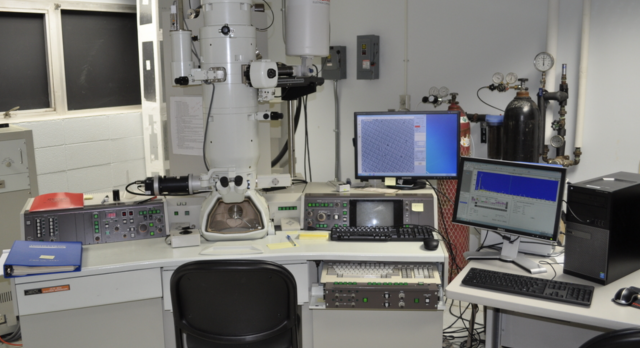When using a light microscope, an image gets produced by using a direct source of light waves. In contrast, when using an electron microscope, a picture is created by using an accelerated electron beam. An eyepiece, an objective, and a condenser lens, among other components, are used to construct the light microscope’s glass-based lens system. An electromagnetic lens, a combination of a condenser, an objective, and a projector lens, is used in the electron microscope to magnify objects.
It is primarily due to two characteristics that distinguish a light microscope from an electron microscope: the source of illumination and the type of lens used.
This is a microscope feature that allows for clear visibility of the object or specimen being examined while also increasing the brightness of the object or specimen gets investigated.
The use of lenses in microscopes is every day, and the function of the lenses varies depending on the type of microscope that is getting utilised. Their primary function is to increase the size of the image that is being seen on the screen.
In this article, we’ll go over discussing light microscope vs electron microscope, as well as a present comparative analysis to help you decide which is better.
In layman’s terms, what exactly is a microscope.
Contents
The term ‘microscope’ refers to a device made up of lenses that, when used in conjunction with a magnifying glass, allows us to see a magnified image of an object or specimen close to us. To investigate the specimen’s internal and external features, we must use a microscope, which allows us to see things that would otherwise be impossible to see.
As implied by the instrument’s name, micro is a term used to describe minute objects, whereas a scope is used to describe distant objects, as in a microscope. To sum up, the microscope is an instrument that allows us to examine and observe microorganisms that are otherwise invisible to the naked eye. An organism is inspected under a microscope, which is referred to as microscopy in the scientific community.
Define a Light Microscope
When it comes to light microscopes, they are well-defined as devices that magnify objects by utilising light as the source of magnification.
A ‘compound microscope’ is another name for this type of microscope. A light microscope is a microscope that examines images under the microscope’s optical microscope objective by shining a light beam on them. A condenser collects and directs the light to the specimen, then examined under a microscope to determine the specimen’s chemical composition. When compared to an electron microscope, the resolution and magnification are significantly lower. Compared to an electron microscope, it has a resolution of approximately 0.2 microns and a magnification of 500–1000 times lower.
Define Electron Microscope
When we say ‘Electron Microscope’, we refer to the following: an optical microscope that transmits electrons to the item under investigation through a beam of accelerated electrons generated by a heated tungsten filament source, which is used to illuminate the object under study. Because of this, it is capable of producing images with a resolution of 0.001 microns, which is 250 times higher than that of a light microscope, and magnifying power of 10,00,000 times greater than that of a light microscope, respectively.
Light Microscope vs Electron Microscope – A Comparative Analysis
There is a significant differencebetween Light microscopes vs Electron microscopes. Let us check it out –
- In contrast to light microscopes, electron microscopes use an electron beam to illuminate the sample under investigation. Between the two types of microscopes, there is a significant difference.
- The light microscope’s low magnifying and resolving powers of 1000X and 0.2m, respectively, poor resolution. In contrast, an electron microscope has high magnification and resolution, with magnification and resolution ranging from 10,000X to 0.001 microns.
- The object is visible directly through the eyepiece of the light microscope, which is a significant convenience. The electron microscope, on the other hand, magnifies the object under investigation using a fluorescent screen.
- It takes more power and technical expertise to operate an electron microscope because of the complexity of its construction. In contrast, it takes less power and technical expertise to operate a light microscope.
- All of the characteristics of an electron microscope, including the use of an electron beam, are absent from the light microscope. A vacuum, tungsten filament, cooling system, and radiation leakage are characteristics of an electron microscope.
- Comparing the light microscope to the electron microscope, the light microscope requires less preparation of the samples.
- For example, while the light microscope can see specimens with a thickness of up to 5 m, the electron microscope is only capable of seeing specimens less than one millimetre thick.
- Specimens that have been stained with chemical dyes have a higher contrast between the microscopic image and the material, which results in a more vibrant specimen. A specimen examined under an electron microscope, on the other hand, is coated with heavy metals that attract the electron beam, resulting in a specimen that is black and white.
- Light microscopes are divided into four types: bright field, dark field, phase contrast, and fluorescent field. Bright field microscopes are the most common type of light microscope. Transmission electron microscopes (TEM), scanning electron microscopes (SEM), and scanning transmission electron microscopes (STEM) are the three types of electron microscopes available (STEM).
Conclusion
The physical characteristics of light and electron microscopes and the structural design and componentry were discussed in detail during the final discussion. Because of this, light and electron microscopes operate on fundamentally different principles, with the former generating images using a light source and the latter generating images using an electron.
The construction and operation of a light microscope are less complicated than those of an electron microscope, even though both microscopes are identical in structure and function. An electron microscope, on the other hand, requires technical expertise.
Keep these notes close at hand to achieve success in your exam preparation!


